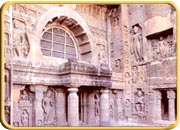Ajanta
Ajanta
Ajanta Caves Technique
 The
ancient artists of Ajanta covered the rough walls with a layer of mud and
cow dung, mixed with straw or animal hair as abindingmedium. This layer was
an inch or an inch-and-a-half thick and, when dry, was smoothend over with
a layer of sieved gypsum or lime plaster. It was upon this that the painters
created their worlds of colour.
The
ancient artists of Ajanta covered the rough walls with a layer of mud and
cow dung, mixed with straw or animal hair as abindingmedium. This layer was
an inch or an inch-and-a-half thick and, when dry, was smoothend over with
a layer of sieved gypsum or lime plaster. It was upon this that the painters
created their worlds of colour.
The paintings in the Ajanta caves are often mistakenly referred to as frescoes.
A fresco refers to the application of colours to moist lime plaster. At Ajanta,
the paintings were done on dry wall.
Another amazing fact about the paintings is that they were done in extremely poor light in the caves. Only very diffused rays of sunlight penetrate the caves, making it difficult to even figure out the murals, let alone paint them.
Various theories have been advanced about how they were completed, ranging from the use of oil lamps, to the use of mirrors to reflect and magnify the little natural light there was. According to an ingenious theory, the depression in the floor of the main chambers, a feature of all caves, was filled with water, which caught the few rays that did reach into the darkness.
However, it seems unlikely that any of these methods could have generated enough light for the minute and detailed work that adorns the Ajanta walls.